When I went to visit Alinghi in Valencia for a day in April, it was to discover a team that was working as hard as possible to get up to speed with the challenge of multihull racing. Skipper Brad Butterworth and the sailing team have acquired two Extreme 40 catamarans to familiarise themselves with the peculiar demands of short course racing aboard fast multihulls.
All their work of recent months would be in vain if Alinghi's legal team failed to persuade Justice Cahn in the New York Supreme Court to delay the 33rd America's Cup match to May 2009. Challenger of Record BMW Oracle Racing started building a 90-foot multihull many months ago in anticipation of a match this October. Alinghi were a long way behind the Americans in designing and building their own 90-footer, and said there would be no chance whatsoever of them being ready for a match this year. There was even talk of them forfeiting the Cup, as it was highly unlikely they would make it to the start line.
However in mid-May, Justice Cahn came out with the announcement that Alinghi had been looking for: that the earliest the racing could take place would be March 2009, with the Defender required to give at least six months' notice of the venue. The Deed of Gift states that for the Cup to take place in the Northern Hemisphere, it must be held between May and November of any given year. So the likeliest outcome from the legal uncertainty that continues to swirl around the 33rd Cup is that the best-of-three-races contest will take place around May or June 2009, venue yet to be confirmed but quite possibly Valencia again.
The sailing team can breathe a big sigh of relief, as now it is game on. For both teams, consisting primarily of world-class sailors with strong monohull sailing backgrounds, it is about learning the unique challenges of racing huge multihulls at high speeds. It has been a steep learning curve, as some of the Alinghi team members discovered when they capsized their borrowed ORMA 60 trimaran, Foncia. The boat's owner Alain Gautier was on board, standing next to helmsman Ed Baird, when the trimaran flipped, hurling sailors through the air. Two crew were injured, fortunately not too seriously, but with extensive damage to the upturned Foncia, not least a broken carbon mast.
Gautier, one of France's most distinguished ocean racers, is acting as a consultant to Alinghi to help them get acquainted and comfortable with multihull sailing as quickly as possible. For him the capsize was all part of Alinghi's sailors getting to grips with these wild beasts. "Ed was the helmsman, I was the skipper, we are a crew. When you capsize a trimaran, the whole crew is responsible. It was a mistake, but you learn when you make mistakes, and the capsize is part of sailing multihulls."
Despite Gautier's generous assessment, this mishap does beg the question why Alinghi, and to a large extent BMW Oracle, are persisting with their sailing team which was built around racing slow, heavy America's Cup keelboats. Surely better to hire some top multihull talent from the Olympics, or from the French offshore scene? Both teams believe otherwise, taking the view that it is better to educate their monohull sailors in the art of multihull racing. As part of that process, both teams have employed the services of a top offshore specialist, Gautier for Alinghi and Franck Cammas for BMW Oracle. Their role is to pass on their hard-earned experience as quickly and efficiently as possible.
Alinghi skipper Brad Butterworth firmly believes this is the right way, to take a group of sailors that already know how each other think, who have already been race-hardened in the previous two America's Cups together. "We're hoping to get the guys up to speed sailing multihulls. The guys are in this sport are professional. They know how to sail boats and adapt themselves to different codes of the sport. We have a lot of multihull experience, and I think we'll wind up with a good cross-section of experience. They're good sailors, they'll work it out, I think."
Ed Baird, the winning helmsman from Alinghi's successful defence of the 32nd Cup last year, is relishing the opportunity to learn some new skills. Daunting, yes, but exciting too. It reminds him of his induction into America's Cup Class sailing, back in the early 90s when he found himself being thrown in at the deep end by Russell Coutts. "The first day I sailed on a Cup class boat, I'd just flown 22 hours from the US to Auckland. Russell Coutts picked me up at the airport, took me back to his house where I had a shower, and I asked him what we were going to do for the day. He said, ‘We're going sailing, you're steering, and we're doing starting practice.'" No time to acclimatise, just straight into the thick of it. "This is the same sort of thing here, learning to sail multihulls, and we have to get on with it."
So how is he getting on with it? "I think people think about monohulls and multihulls as being dramatically different, and the fact is, in many ways they're not. You power them up in the same way, tactics are not so different in some ways. But the faster the boat, the more precise your steering needs to be. Just moving your fingers can be the difference between flying a hull, or even whether you capsize or not."
On the day I visited, Alinghi conducted a series of short races between their black and white 40-footers, the identical Extreme 40 catamarans. I got to ride as fifth man, the spectator, on board Baird's boat for one of the races, and already he looked extremely comfortable at the helm. Then again, he's going to need to be, because this summer he represents Alinghi on the iShares Cup circuit, a European city tour which will see 15 of these one-design catamarans racing each other on very short, restricted courses. Water-borne dodgem racing against Olympic sailors and multihull specialists, as well as their nemesis, BMW Oracle Racing, who are using the iShares circuit for the same purpose. Some needle match that will be.
But just how relevant will racing in 40-foot production catamarans be to the main event, the prospect of a three-race series in 90-foot custom-built leviathans, the likes of which have never been seen? Not very, according to Baird, Butterworth, or anyone else you care to ask. Which is why they're more comfortable working with the existing team members they have, rather than bringing in the multihull experts, whose experience they believe will be of limited value to the unique challenge that they face.
When we went racing in the Extreme 40s in Valencia, Baird won each of his five matches against the black boat, steered by Murray Jones with Brad Butterworth on board. This should be no surprise, as Baird has had more time on the 40-footer than Jones, but the distance by which he was winning the races in a match race between one-designs suggests that we're highly unlikely to witness a repeat of the drama that kept us enthralled last year, with the most closely fought America's Cup match in more than a century and a half of history.
Neither team knows what the other is building, not even whether they're building two hulls or three. Baird is not expecting a close fight. "It would be shocking if the boats were very similar. They're both going to be big, but they're going to be different. That means one boat will be faster than the other, so it won't be exciting racing."
However, what these boats will certainly be is exciting, and dangerous. How dangerous? "Very," says Butterworth, matter of factly. "It depends how fast these boats are going to go and on the sea state. My understanding is that these boats will be extremely fast and extremely powerful. The loads will be right up there. I don't think that's a recipe for being safe, but anyway..."
Gautier picks up the theme. "Sometimes it can be very dangerous. [If you capsize] you could have more than 40 metres of flying through the air, before you hit the mast or the water. Sailing at 35 or 38 knots gives you some adrenalin that you didn't have with the typical America's Cup boat." Although the design team is unwilling to reveal any hard data from their months of research, Gautier suggests that these boats will be capable of 20 knots boatspeed upwind, and up to 40 knots downwind.
This will be crash helmet sailing. It's clear from talking to the design team that they are immensely excited by the challenge of designing and building a boat with no real precedent, but that they also feel the responsibility and pressure of building something that will keep the sailors safe. The 33rd Cup looks likely to be won more by good design and construction than by superior sailing skills. Not much for the world's greatest tactician to do this time, then? "I think that's right," says Butterworth. "Tacking will be expensive, you'll see the boats going in different directions. It will be more like a Nascar event."
Does that make the 33rd Cup any less valid? "It's still a design and sailing event. This will be more back to what it was in the past. I don't think anyone can envisage the size and power of these boats. I don't think the multihull fraternity has had this much money thrown at it before. There is a lot of resource that goes into designing these boats to the nth degree. It will be quite spectacular."
So this will be the first Cup to be contested by two multihulls, but will it be the last? "It's up to the guys that own these teams," says Butterworth, "but if it was up to me, I don't know why you'd go back. These boats are expensive. It's an expensive regatta with just two teams, and once you build one of these boats, I don't know why you'd bother going back to something that's slower. Sure people liked the multi-team event, but it's not happening this time, and maybe it won't happen again for a while."

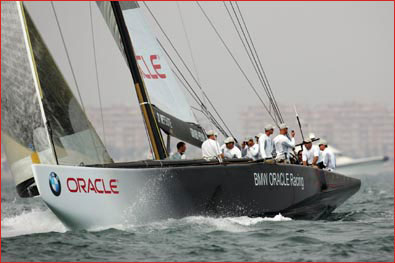 BMW Oracle has been carrying out some extensive TV trials of monohulls and multihulls in Valencia. The aim, says the Defender, is to work out which kind of boat is going to offer the biggest bang for buck in Russell Coutts’s vision of a more media-friendly and commercially-attractive America’s Cup...
BMW Oracle has been carrying out some extensive TV trials of monohulls and multihulls in Valencia. The aim, says the Defender, is to work out which kind of boat is going to offer the biggest bang for buck in Russell Coutts’s vision of a more media-friendly and commercially-attractive America’s Cup...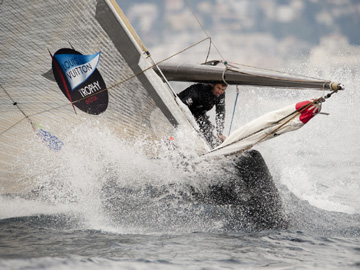 Louis Vuitton has been an integral part of the America’s Cup since the luxury goods company first gave its name to the Louis Vuitton Challenger Series back in Newport 1983. That close association continued up to Valencia 2007, but following Alinghi’s successful defence of the Cup, Louis Vuitton withdrew its backing...
Louis Vuitton has been an integral part of the America’s Cup since the luxury goods company first gave its name to the Louis Vuitton Challenger Series back in Newport 1983. That close association continued up to Valencia 2007, but following Alinghi’s successful defence of the Cup, Louis Vuitton withdrew its backing...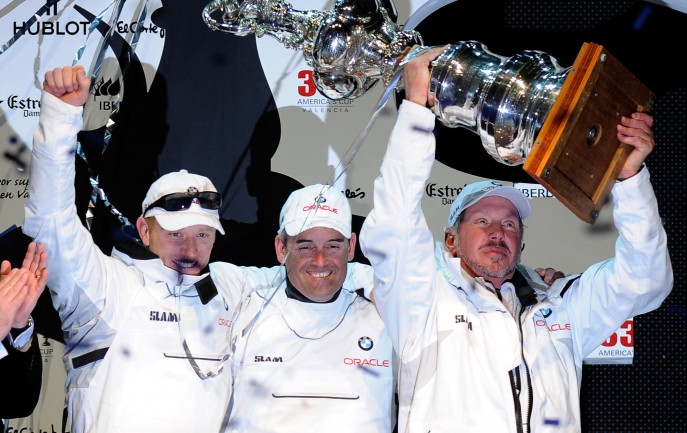 So now we’ve seen the power of wing rigs in action in the America’s Cup, what possibility of a trickledown of technology into other forms of sailing? What about superyachts? BMW Oracle’s design team director Mike Drummond observed, tongue in cheek: “If you go to Wings R Us.com, you can get any size you like.” Of course, this technology is anything but off the shelf, but nor is it new, as Drummond also pointed out: “Wings are not new, they’ve been used by birds for quite a long time...
So now we’ve seen the power of wing rigs in action in the America’s Cup, what possibility of a trickledown of technology into other forms of sailing? What about superyachts? BMW Oracle’s design team director Mike Drummond observed, tongue in cheek: “If you go to Wings R Us.com, you can get any size you like.” Of course, this technology is anything but off the shelf, but nor is it new, as Drummond also pointed out: “Wings are not new, they’ve been used by birds for quite a long time...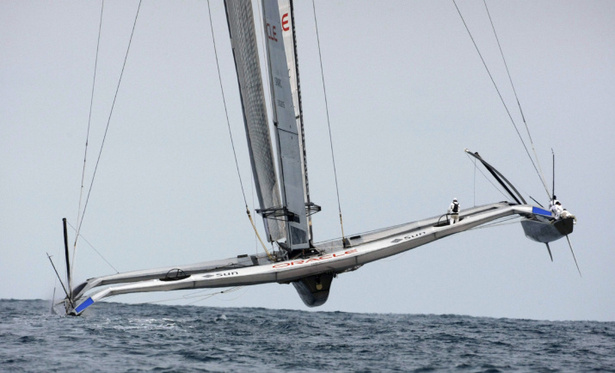 So now we know. Wings trump sails. Theory has always stated that a wing rig should be faster than conventional sails. But the challenge was actually to put a wing rig into practice, to be able to build it in less than six months, and also to manage the logistics of it...
So now we know. Wings trump sails. Theory has always stated that a wing rig should be faster than conventional sails. But the challenge was actually to put a wing rig into practice, to be able to build it in less than six months, and also to manage the logistics of it...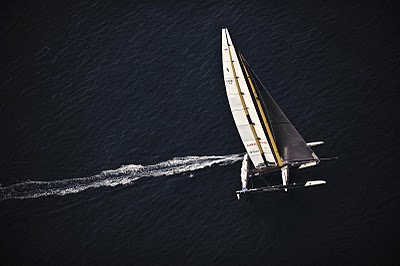 Race 2 was set to take place two days later on the Sunday. It was another long wait while Harold Bennett looked for suitable conditions in which to start the race. The cut-off time of 4pm was just minutes away when Bennett called for the start procedure to begin...
Race 2 was set to take place two days later on the Sunday. It was another long wait while Harold Bennett looked for suitable conditions in which to start the race. The cut-off time of 4pm was just minutes away when Bennett called for the start procedure to begin...